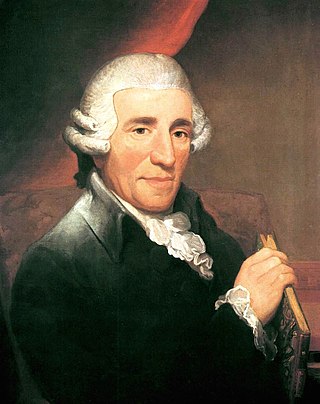Symphony No. 39 is a symphony in G minor by Franz Joseph Haydn in 1765, at the age of 33 under the beneficence of Prince Nikolaus Esterházy. It is the earliest of Haydn's minor key symphonies associated with his Sturm und Drang period works.

Symphony No. 67 in F major, Hoboken I/67, is a symphony by Joseph Haydn. It was composed by 1779. The Haydn scholar H. C. Robbins Landon calls this work "one of the most boldly original symphonies of this period."

The Symphony No. 52 in C minor is one of the last Sturm und Drang symphonies composed by the Austrian composer Joseph Haydn while the composer was in residence at Esterházy in 1771 or 1772.

The Symphony No. 48 in C major, Hoboken I/48, is a symphony by Joseph Haydn written in 1768 or 1769. The work has the nickname Maria Theresa as it was long thought to have been composed for a visit by the Holy Roman Empress, Maria Theresa of Austria in 1773. An earlier copy dated 1769 was later found, but the nickname has stuck. The symphony composed for the empress's visit was most likely No. 50.

The Symphony No. 37 in C major, Hob. I/37, is a symphony by Franz Joseph Haydn. The numbering is completely misleading, as it is clearly one of Haydn's earliest symphonies. A copy of the score found at Český Krumlov, Czech Republic, is dated 1758. It can be presumed it was written for the orchestra of Count Morzin, in which Haydn was employed until February 1761.

Symphony No. 35 in B♭ major, Hoboken I/35, was written by Joseph Haydn. The autograph score is "carefully" dated "December 10, 1767". It has been speculated that this symphony was written to celebrate Prince Esterházy's return from a visit to the Palace of Versailles.

The Symphony No. 32 in C major is a festive symphony by Joseph Haydn. The exact date of composition is unknown. It has been suggested by noted Haydn scholar H.C. Robbins Landon that it could have been written as early as 1757 and as late as 1763. More recent scholars have suggested it was composed in either 1760 or 1761

The Symphony No. 33 in C major is a festive symphony by Joseph Haydn. The precise date of composition is unknown. Haydn scholar H.C. Robbins Landon has dated this work to 1763–65. It has also been suggested that it was written in 1760 or 1761, along with Symphony no. 32.

Joseph Haydn wrote Symphony No. 23 in G major, Hoboken I/23, in 1764.

The Symphony No. 25 in C major, Hoboken I/25, is a symphony by Joseph Haydn.The symphony was most likely composed in 1763, or at the very earliest in 1761, at about the same time as No. 33.

The Symphony No. 20 in C major is a festive symphony by Joseph Haydn. Hodgson places the composition date in either 1761 or 1762 while Brown states that it was likely composed before 1761. Calvin Stapert affirmatively states that it was composed in the group of 15 symphonies within Haydn's tenure with Count Morzin. And is festive, like C major Symphonies 32, 33, and 37. It is scored for 2 oboes, bassoon, 2 horns, 2 trumpets, timpani, strings and continuo. The symphony is in four movements:
- Allegro molto, 2
4 - Andante cantabile, 2
2 in G major - Minuetto & Trio, F major 3
4 - Presto, 3
8

Joseph Haydn's Symphony No. 1 in D major, Hoboken I/1, was written in 1759 in Dolní Lukavice, while in the service of Count Morzin. While it is reliably known that No. 1 was written in 1759, H. C. Robbins Landon cannot rule out that No. 2, No. 4, or both could have been composed in 1757 or 1758.

Joseph Haydn's Symphony No. 2 in C major, Hoboken I/2, is believed to have been written between 1757 and 1761.
Joseph Haydn's Symphony No. 4 in D major, Hoboken I/4, is believed to have been written between 1757 and 1761.

Joseph Haydn's Symphony No. 16 in B-flat major, Hoboken I/16, may have been written between 1757 and 1761.

Joseph Haydn's Symphony No. 17 in F major, Hoboken I/17, may have been written between 1757 and 1763.

The Symphony No. 18 in G major, Hoboken I/18, is a symphony by Joseph Haydn. The composition date is conspicuously uncertain. The Breitkopf catalogue entry assures that it was composed no later than March 1766, the date of the Esterhazy orchestra moving to Esterhaza, but most scholars believe it was composed at least a few years before then. Dates between 1757 and 1764 have been also suggested but not proven.

The Symphony No. 19 in D major, Hoboken I/19, is a symphony by Joseph Haydn. The symphony was composed between 1757 and 1761.
Joseph Haydn's Symphony 'A' in B♭ major, Hoboken I/107, was written between 1757 and 1760. It therefore must have been composed for Count Morzin's orchestra, for whom Haydn worked until 1761.


